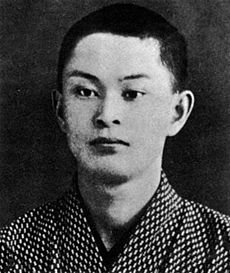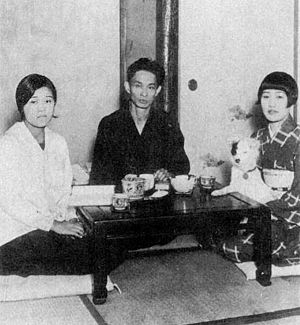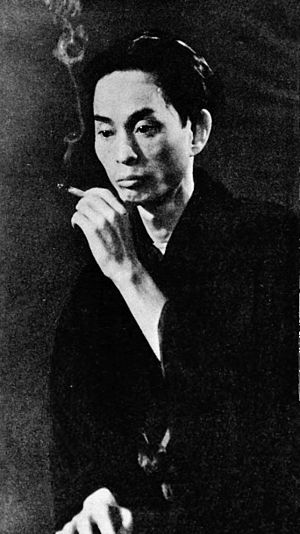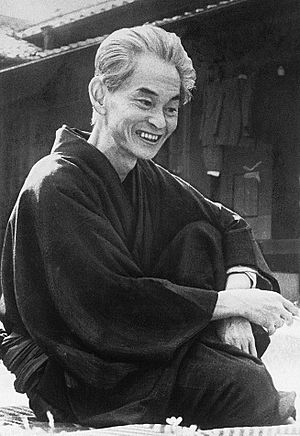Yasunari Kawabata facts for kids
Quick facts for kids
Yasunari Kawabata
|
|||||
|---|---|---|---|---|---|
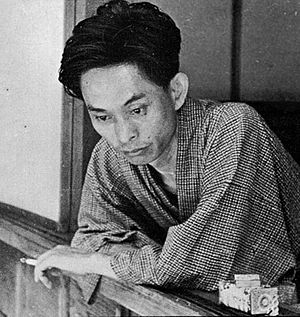
Kawabata at his home in Kamakura
|
|||||
| Born | 11 June 1899 Osaka, Japan |
||||
| Died | 16 April 1972 (aged 72) Zushi, Kanagawa, Japan |
||||
| Occupation | Writer | ||||
| Alma mater | University of Tokyo | ||||
| Period | 1924–1972 | ||||
| Genre | Novels, short stories | ||||
| Literary movement | Shinkankakuha | ||||
| Notable works | Snow Country, The Master of Go, The Dancing Girl of Izu, The Old Capital | ||||
| Notable awards | Nobel Prize in Literature 1968 |
||||
| Spouse | Hideko Kawabata | ||||
| Japanese name | |||||
| Kanji | 川端 康成 | ||||
| Hiragana | かわばた やすなり | ||||
| Katakana | カワバタ ヤスナリ | ||||
|
|||||
Yasunari Kawabata (川端 康成, Kawabata Yasunari, 11 June 1899 – 16 April 1972) was a Japanese novelist and short story writer whose spare, lyrical, subtly shaded prose works won him the Nobel Prize in Literature in 1968, the first Japanese author to receive the award. His works have enjoyed broad international appeal and are still widely read.
Contents
Early life
Born into a well-established family in Osaka, Japan, Kawabata was orphaned by the time he was four, after which he lived with his grandparents. He had an older sister who was taken in by an aunt, and whom he met only once thereafter, in July 1909, when he was ten. She died when Kawabata was 11. Kawabata's grandmother died in September 1906, when he was seven, and his grandfather in May 1914, when he was fifteen.
Having lost all close paternal relatives, Kawabata moved in with his mother's family, the Kurodas. However, in January 1916, he moved into a boarding house near the junior high school (comparable to a modern high school) to which he had formerly commuted by train. After graduating in March 1917, Kawabata moved to Tokyo just before his 18th birthday. He hoped to pass the exams for Dai-ichi Kōtō-gakkō (First Upper School), which was under the direction of the Tokyo Imperial University. He succeeded in the exam the same year and entered the Humanities Faculty as an English major in July 1920. The young Kawabata, by this time, was enamoured of the works of another Asian Nobel laureate, Rabindranath Tagore.
One of Kawabata's painful love episodes was with Hatsuyo Itō (伊藤初代, 1906–1951), whom he met when he was 20 years old. An unsent love letter to her was found at his former residence in Kamakura, Kanagawa Prefecture, in 2014.
While still a university student, Kawabata re-established the Tokyo University literary magazine Shin-shichō (New Tide of Thought), which had been defunct for more than four years. There he published his first short story, "Shokonsai ikkei" ("A View from Yasukuni Festival") in 1921. During university, he changed faculties to Japanese literature and wrote a graduation thesis titled "A short history of Japanese novels". He graduated from university in March 1924, by which time he had already caught the attention of Kikuchi Kan and other noted writers and editors through his submissions to Kikuchi's literary magazine, the Bungei Shunju.
New writing movement
In October 1924, Kawabata, Riichi Yokomitsu and other young writers started a new literary journal Bungei Jidai (The Artistic Age). This journal was a reaction to the entrenched old school of Japanese literature, specifically the Japanese movement descended from Naturalism, while it also stood in opposition to the "workers'" or proletarian literature movement of the Socialist/Communist schools. It was an "art for art's sake" movement, influenced by European Cubism, Expressionism, Dada, and other modernist styles. The term Shinkankakuha, which Kawabata and Yokomitsu used to describe their philosophy, has often been mistakenly translated into English as "Neo-Impressionism". However, Shinkankakuha was not meant to be an updated or restored version of Impressionism; it focused on offering "new impressions" or, more accurately, "new sensations" or "new perceptions" in the writing of literature. An early example from this period is the draft of Hoshi wo nusunda chichi (The Father who stole a Star), an adaption of Ferenc Molnár's play Liliom.
Career
Kawabata started to achieve recognition for a number of his short stories shortly after he graduated, receiving acclaim for "The Dancing Girl of Izu" in 1926, a story about a melancholy student who, on a walking trip down Izu Peninsula, meets a young dancer, and returns to Tokyo in much improved spirits.
In the 1920s, Kawabata was living in the plebeian district of Asakusa, Tokyo. During this period, Kawabata experimented with different styles of writing. In Asakusa kurenaidan (The Scarlet Gang of Asakusa), serialized from 1929 to 1930, he explores the lives of the demimonde and others on the fringe of society, in a style echoing that of late Edo period literature. On the other hand, his Suisho genso (Crystal Fantasy) is pure stream-of-consciousness writing. He was even involved in writing the script for the experimental film A Page of Madness.
In 1933, Kawabata protested publicly against the arrest and death of the young leftist writer Takiji Kobayashi in Tokyo by the Tokkō special political police.
Kawabata relocated from Asakusa to Kamakura, Kanagawa Prefecture, in 1934 and, although he initially enjoyed a very active social life among the many other writers and literary people residing in that city during the war years and immediately thereafter, in his later years he became very reclusive.
One of his most famous novels was Snow Country, started in 1934 and first published in installments from 1935 through 1937. Snow Country is a stark tale of a love affair between a Tokyo dilettante and a provincial geisha, which takes place in a remote hot-spring town somewhere in the mountainous regions of northern Japan. It established Kawabata as one of Japan's foremost authors and became an instant classic, described by Edward G. Seidensticker as "perhaps Kawabata's masterpiece".
After the end of World War II, Kawabata's success continued with novels such as Thousand Cranes (a story of ill-fated love), The Sound of the Mountain, The House of the Sleeping Beauties, Beauty and Sadness, and The Old Capital.
His two most important post-war works are Thousand Cranes (serialized 1949–1951), and The Sound of the Mountain (serialized 1949–1954).
The book that Kawabata himself considered his finest work, The Master of Go (1951), contrasts sharply with his other works. It is a semi-fictional recounting of a major Go match in 1938, on which he had actually reported for the Mainichi newspaper chain. It was the last game of master Shūsai's career and he lost to his younger challenger, Minoru Kitani, only to die a little over a year later. Although the novel is moving on the surface as a retelling of a climactic struggle, some readers consider it a symbolic parallel to the defeat of Japan in World War II.
Through many of Kawabata's works the sense of distance in his life is represented. He often gives the impression that his characters have built up a wall around them that moves them into isolation. In a 1934 published work Kawabata wrote: "I feel as though I have never held a woman's hand in a romantic sense [...] Am I a happy man deserving of pity?”. Indeed, this does not have to be taken literally, but it does show the type of emotional insecurity that Kawabata felt, especially experiencing two painful love affairs at a young age.
Kawabata left many of his stories apparently unfinished, sometimes to the annoyance of readers and reviewers, but this goes hand to hand with his aesthetics of art for art's sake, leaving outside any sentimentalism, or morality, that an ending would give to any book. This was done intentionally, as Kawabata felt that vignettes of incidents along the way were far more important than conclusions. He equated his form of writing with the traditional poetry of Japan, the haiku.
In addition to fictional writing, Kawabata also worked as a reporter, most notably for the Mainichi Shimbun. Although he refused to participate in the militaristic fervor that accompanied World War II, he also demonstrated little interest in postwar political reforms. Along with the death of all his family members while he was young, Kawabata suggested that the war was one of the greatest influences on his work, stating he would be able to write only elegies in postwar Japan. Still, many commentators detect little thematic change between Kawabata's prewar and postwar writings.
Awards
As the president of Japanese P.E.N. for many years after the war (1948–1965), Kawabata was a driving force behind the translation of Japanese literature into English and other Western languages. He was appointed an Officer of the Order of Arts and Letters of France in 1960, and awarded Japan's Order of Culture the following year.
Nobel Prize
Kawabata was awarded the Nobel Prize for Literature on 16 October 1968, the first Japanese person to receive such a distinction. In awarding the prize "for his narrative mastery, which with great sensibility expresses the essence of the Japanese mind", the Nobel Committee cited three of his novels, Snow Country, Thousand Cranes, and The Old Capital.
Death
Kawabata apparently died in 1972. A number of close associates and friends, including his widow, consider his death to have been accidental.
Selected works
| Year | Japanese Title | English Title | English Translation |
|---|---|---|---|
| 1926 | 伊豆の踊子 Izu no odoriko |
The Dancing Girl of Izu | 1955, 1998 |
| 1930 | 浅草紅團 Asakusa kurenaidan |
The Scarlet Gang of Asakusa | 2005 |
| 1935–1937, 1947 |
雪国 Yukiguni |
Snow Country | 1956, 1996 |
| 1951–1954 | 名人 Meijin |
The Master of Go | 1972 |
| 1949–1952 | 千羽鶴 Senbazuru |
Thousand Cranes | 1958 |
| 1949–1954 | 山の音 Yama no oto |
The Sound of the Mountain | 1970 |
| 1954 | みづうみ(みずうみ) Mizuumi |
The Lake | 1974 |
| 1961 | 眠れる美女 Nemureru bijo |
The House of the Sleeping Beauties | 1969 |
| 1962 | 古都 Koto |
The Old Capital | 1987, 2006 |
| 1964 | 美しさと哀しみと Utsukushisa to kanashimi to |
Beauty and Sadness | 1975 |
| 1964 | 片腕 Kataude |
One Arm | 1969 |
| 1964–1968, 1972 | たんぽぽ Tanpopo |
Dandelions | 2017 |
| 1923–1972 | 掌の小説 Tanagokoro no shōsetsu |
Palm-of-the-Hand Stories | 1988 |
Related pages
See also
 In Spanish: Yasunari Kawabata para niños
In Spanish: Yasunari Kawabata para niños
- List of Japanese Nobel laureates
- List of Nobel laureates affiliated with the University of Tokyo
- The Moon in the Water: Understanding Tanizaki, Kawabata, and Mishima


